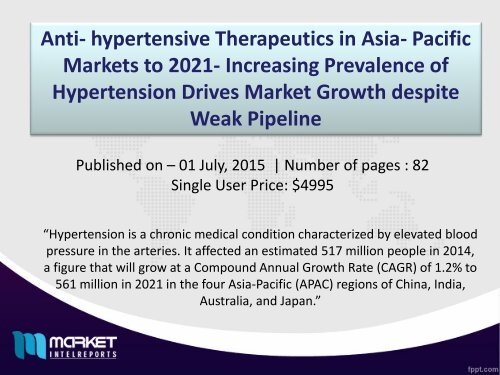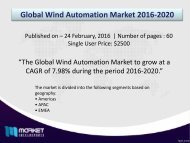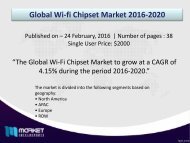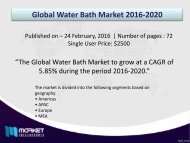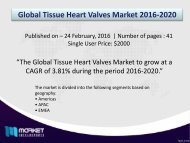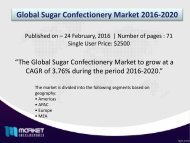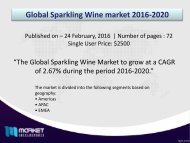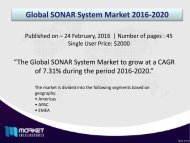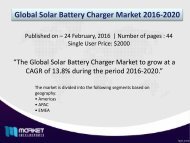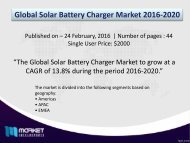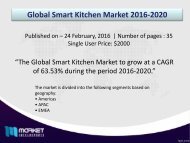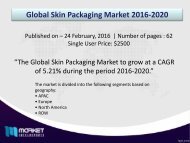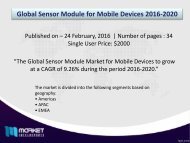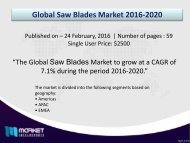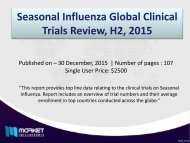APAC Anti-Hypertensive Therapeutics Market will be valued at 19.9 billion in 2021
Hypertension is a chronic medical condition characterized by elevated blood pressure in the arteries. It affected an estimated 517 million people in 2014, a figure that will grow at a Compound Annual Growth Rate (CAGR) of 1.2% to 561 million in 2021 in the four Asia-Pacific (APAC) regions of China, India, Australia, and Japan.
Hypertension is a chronic medical condition characterized by elevated blood pressure in the arteries. It affected an estimated 517 million people in 2014, a figure that will grow at a Compound Annual Growth Rate (CAGR) of 1.2% to 561 million in 2021 in the four Asia-Pacific (APAC) regions of China, India, Australia, and Japan.
Create successful ePaper yourself
Turn your PDF publications into a flip-book with our unique Google optimized e-Paper software.
<strong>Anti</strong>- hypertensive <strong>Therapeutics</strong> <strong>in</strong> Asia- Pacific<br />
<strong>Market</strong>s to <strong>2021</strong>- Increas<strong>in</strong>g Prevalence of<br />
Hypertension Drives <strong>Market</strong> Growth despite<br />
Weak Pipel<strong>in</strong>e<br />
Published on – 01 July, 2015 | Num<strong>be</strong>r of pages : 82<br />
S<strong>in</strong>gle User Price: $4995<br />
“Hypertension is a chronic medical condition characterized by elev<strong>at</strong>ed blood<br />
pressure <strong>in</strong> the arteries. It affected an estim<strong>at</strong>ed 517 million people <strong>in</strong> 2014,<br />
a figure th<strong>at</strong> <strong>will</strong> grow <strong>at</strong> a Compound Annual Growth R<strong>at</strong>e (CAGR) of 1.2% to<br />
561 million <strong>in</strong> <strong>2021</strong> <strong>in</strong> the four Asia-Pacific (<strong>APAC</strong>) regions of Ch<strong>in</strong>a, India,<br />
Australia, and Japan.”
Summary of the Report:<br />
Hypertension is a chronic medical condition characterized by elev<strong>at</strong>ed blood pressure <strong>in</strong> the<br />
arteries. It affected an estim<strong>at</strong>ed 517 million people <strong>in</strong> 2014, a figure th<strong>at</strong> <strong>will</strong> grow <strong>at</strong> a<br />
Compound Annual Growth R<strong>at</strong>e (CAGR) of 1.2% to 561 million <strong>in</strong> <strong>2021</strong> <strong>in</strong> the four Asia-Pacific<br />
(<strong>APAC</strong>) regions of Ch<strong>in</strong>a, India, Australia, and Japan. This high prevalence is a substantial<br />
contributor to healthcare costs and a major cause of morbidity. Despite this, awareness of<br />
hypertension is low among physicians, p<strong>at</strong>ients, and the public alike, lead<strong>in</strong>g to poor blood<br />
pressure control.<br />
The classes of drugs prescri<strong>be</strong>d to tre<strong>at</strong> hypertension are Angiotens<strong>in</strong> Convert<strong>in</strong>g Enzyme<br />
Inhibitors (ACEI), Angiotens<strong>in</strong> Receptor Blockers (ARB), Calcium Channel Blockers (CCB), <strong>be</strong>tablockers,<br />
ren<strong>in</strong> <strong>in</strong>hibitors, and diuretics. The percentage of p<strong>at</strong>ients tre<strong>at</strong>ed us<strong>in</strong>g monotherapy<br />
and comb<strong>in</strong><strong>at</strong>ion therapy (<strong>in</strong>clud<strong>in</strong>g fixed-dose comb<strong>in</strong><strong>at</strong>ions) varies from country to country. The<br />
most commonly prescri<strong>be</strong>d drugs <strong>in</strong> the CCB class are amlodip<strong>in</strong>e and lercanidip<strong>in</strong>e, while the<br />
lead<strong>in</strong>g ARBs are telmisartan, candesartan, olmesartan, ir<strong>be</strong>sartan, losartan, valsartan, azilsartan<br />
medoxomil, and eprosartan. Ramipril, imidapril, per<strong>in</strong>dopril, enalapril, lis<strong>in</strong>opril, <strong>be</strong>nazepril,<br />
fos<strong>in</strong>opril, trandolapril, and qu<strong>in</strong>april dom<strong>in</strong><strong>at</strong>e the ACEIs.<br />
Click Here To Check Complete Report
Scope of the Report:<br />
Hypertension prevalence is a prom<strong>in</strong>ent contributor to market size <strong>in</strong> the assessed<br />
countries. The market is mostly dom<strong>in</strong><strong>at</strong>ed by generics, and there are only a few p<strong>at</strong>ented<br />
products.<br />
Will generics cont<strong>in</strong>ue to dom<strong>in</strong><strong>at</strong>e tre<strong>at</strong>ment?<br />
How do the elderly popul<strong>at</strong>ions and their associ<strong>at</strong>ed risk factors affect prevalence?<br />
The current anti-hypertensive therapeutics pipel<strong>in</strong>e is weak, compris<strong>in</strong>g 124 molecules<br />
<strong>in</strong> various stages of development, dom<strong>in</strong><strong>at</strong>ed by small molecules.<br />
Will the upcom<strong>in</strong>g molecules change the tre<strong>at</strong>ment paradigm <strong>in</strong> the near future?<br />
How <strong>will</strong> the weak pipel<strong>in</strong>e affect the market?<br />
Analysis of cl<strong>in</strong>ical trials s<strong>in</strong>ce 2006 identified th<strong>at</strong> anti-hypertensive products have a<br />
high r<strong>at</strong>e of <strong>at</strong>trition.<br />
How do failure r<strong>at</strong>es vary by product stage of development, molecule type, and<br />
mechanism of action?<br />
How do other factors such as average trial dur<strong>at</strong>ion and trial size <strong>in</strong>fluence the costs and<br />
risks associ<strong>at</strong>ed with product development?<br />
Over the 2014–<strong>2021</strong> forecast period, the <strong>APAC</strong> anti-hypertensive therapeutics market is<br />
expected to <strong>in</strong>crease <strong>in</strong> value <strong>at</strong> a CAGR of 3.4% from $15.7 <strong>billion</strong> to just over $<strong>19.9</strong><br />
<strong>billion</strong>. Growth is projected to vary considerably across the four assessed markets.<br />
Download<br />
Sample Brochure
Reasons to buy:<br />
This report <strong>will</strong> enable you to -<br />
Understand the cl<strong>in</strong>ical context of hypertension by consider<strong>in</strong>g symptoms, etiology,<br />
p<strong>at</strong>hophysiology, co-morbidities and complic<strong>at</strong>ions, epidemiology, diagnosis, and<br />
tre<strong>at</strong>ment options.<br />
Identify the therapeutic str<strong>at</strong>egies, products, and companies th<strong>at</strong> dom<strong>in</strong><strong>at</strong>e the current<br />
marketed products landscape, and recognize gaps.<br />
Appreci<strong>at</strong>e key anti-hypertensive pipel<strong>in</strong>e trends <strong>in</strong> molecule type, adm<strong>in</strong>istr<strong>at</strong>ion route,<br />
mechanism of action, and novelty.<br />
Consider market opportunities and potential risks by exam<strong>in</strong><strong>in</strong>g trends <strong>in</strong> antihypertensive<br />
cl<strong>in</strong>ical trial size, dur<strong>at</strong>ion, and failure r<strong>at</strong>e by stage of development,<br />
molecule type, and mechanism of action.<br />
Compare tre<strong>at</strong>ment usage p<strong>at</strong>terns, annual therapy costs, and market growth projections<br />
for the Ch<strong>in</strong>a, India, Australia, and Japan.<br />
Discover trends <strong>in</strong> licens<strong>in</strong>g and co-development deals concern<strong>in</strong>g anti-hypertensive<br />
products and identify the major str<strong>at</strong>egic consolid<strong>at</strong>ions th<strong>at</strong> have shaped the<br />
commercial landscape.<br />
Make an Inquiry<br />
Before Buy<strong>in</strong>g
<strong>Anti</strong>- hypertensive <strong>Therapeutics</strong> <strong>in</strong> Asia- Pacific <strong>Market</strong>s to<br />
<strong>2021</strong>- Increas<strong>in</strong>g Prevalence of Hypertension Drives<br />
<strong>Market</strong> Growth despite Weak Pipel<strong>in</strong>e<br />
A detailed qualit<strong>at</strong>ive analysis of the factors responsible for driv<strong>in</strong>g and restra<strong>in</strong><strong>in</strong>g<br />
growth of the <strong>APAC</strong> <strong>Anti</strong>-<strong>Hypertensive</strong> <strong>Therapeutics</strong> <strong>Market</strong> are provided <strong>in</strong> the<br />
report.<br />
Contact:<br />
1-302-684-6088<br />
sales@market<strong>in</strong>telreports.com<br />
www.market<strong>in</strong>telreports.com<br />
Click here to order a copy of <strong>APAC</strong><br />
<strong>Anti</strong>-<strong>Hypertensive</strong> <strong>Therapeutics</strong><br />
<strong>Market</strong> Report


